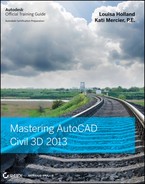Chapter 12
Superelevation
Superelevation and cant tools have matured greatly since the early releases, and theAutoCAD® Civil 3D® 2013 software has added even more functionality.
Before you can understand the superelevation tools, you should have a good grasp of alignments, assemblies, and corridors. You may want to refer to the corresponding chapters for a refresher on those topics before attempting to put superelevation or cant into practice.
In this chapter, you will learn to:
- Add superelevation to an alignment
- Create a superelevation assembly
- Create a rail corridor with cant
- Create a superelevation view
Getting Ready for Super
Several pieces need to be in place before superelevation can be applied to the design. You will need a design criteria file appropriate for your locale, design speeds applied to an alignment, and an assembly that is capable of superelevating.
There are a lot of abbreviations and terminology thrown around when it comes to superelevation, so let's take a look at that first.
When an assembly is applied without superelevation, the geometry comes directly from the original design, as shown in Figure 12.1.
Figure 12.1 An example assembly without superelevation

As the assembly begins its entrance into a curve with superelevation applied to it, it will first start to lose its normal crown. Figure 12.2 shows the same assembly at the End Normal Crown (ENC) station.
Figure 12.2 At the End Normal Crown (ENC) station, the default lane slope starts to change.

When the assembly has one side flattened out, as shown in Figure 12.3, it is called Level Crown (LC).
Figure 12.3 Level Crown entering a left-hand turn

When the assembly straightens out into a plane that matches the inside lane, it is called Reverse Crown (RC), as shown in Figure 12.4.
Figure 12.4 Reverse Crown (RC)

If accommodations have been made for shoulder slope rollover and breakover removal, the shoulder will shift as well. The left image of Figure 12.5 shows where the superelevated lane becomes steep enough to cause an outside rollover problem with the outside shoulder. The shoulder begins to adjust to increase the safety of the road. The right image of Figure 12.5 shows the change in the lower shoulder.
Figure 12.5 Begin Shoulder Rollover (BSR) (left) and Low Shoulder Match (LSM) (right)

Finally, the lane gets to its maximum slope at the Begin Full Super (BFS) station. As you can see in Figure 12.6, all the geometry adjustment has taken place.
Figure 12.6 Begin Full Super (BFS)
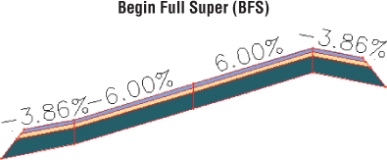
On the way out of the curve, you will see the geometry transitioning back to its original design. It will pass through End Full Super (EFS), Low Shoulder Match (LSM), Reverse Crown (RC), Level Crown (LC), Begin Normal Crown (BNC), and finally back to Begin Normal Shoulder (BNS).
Now that you are familiar with the terminology and abbreviations Civil 3D uses, let's get started on some design.
Design Criteria Files
Having the correct design criteria file in place is the first step to applying superelevation to your corridor. These XML-based files contain instructions to the software on when to flag your design for geometry problems both horizontally and vertically. Design criteria files are the brains behind how your road behaves when superelevation is applied to the design.
Several design criteria files are supplied with Civil 3D upon installation. The out-of-the-box standards include AASHTO 2001 and AASHTO 2004 for both metric and Imperial units. Several of the country kits include design criteria files for your locality if you are outside of the United States. If country or state kits do not exist for your situation, you can create your own, user-defined files.
To create your own design criteria:
C:ProgramDataAutodeskC3D 2013enuDataCorridor Design Standards
C:ProgramDataAutodeskC3D 2013enuDataRailway Design Standards
Inside the Design Criteria Editor (Figure 12.7), you will see three headings: Units, Alignments, and Profiles. The Units page tells Civil 3D what type of values it will be using in the file. The Alignments page is used for checking design, creating superelevation, and widening outside curves. The Profiles page provides tabular data for minimum K value used to check vertical design.
Figure 12.7 Inside the Design Criteria Editor

Civil 3D will graphically flag alignments when the design speed specified in the alignment properties has a radius less than the value specified in the Minimum Radius Table. The Minimum Radius Tables from AASHTO use superelevation rates in the table names, but this does not lock you into that rate for applying superelevation to the corridor. In other words, just because you use a more conservative value in your radius check, that doesn't mean you can't superelevate at a steeper rate. The tables are independent of one another.
Also in the Alignments page you will find the superelevation attainment equations. These equations determine the distance between superelevation critical stations. Familiarize yourself with the terminology and locations represented by these stations, as shown in Figure 12.8.
Figure 12.8 Superelevation critical stations and regions calculated by Civil 3D

In the following exercise, you will modify an example design criteria file and save it:

![]()
Figure 12.9 Adding a design speed to the design criteria file

| Curve radius (feet) | Curve radius (meters) | Superelevation % |
| 300 | 90 | 6 |
| 1000 | 300 | 4.5 |
| 1500 | 450 | 3.2 |
| 2000 | 600 | 2.6 |
| 4000 | 1250 | NC |
Figure 12.10 Adding example data using the Design Criteria Editor

Ready Your Alignment
Superelevation stations are connected to alignment curves. The design speed from the alignment properties is needed at each curve to specify which superelevation rate tables to use from the design criteria. The design speed has an effect on the distance between superelevation critical stations and the cross-slope used when the road is at full-super.
It is a good idea to get your alignment geometry and design speed locations finalized before attaching superelevation. If a change is made to your alignment, the superelevation stationing will be marked as out of date.
Super Assemblies
As a general rule, if the lane subassembly has the word “super” somewhere in its name, it will respond to superelevation. If you want to verify that the lane you are choosing will behave the way you want it to in a superelevation situation, you can right-click it from the tool palette and access the subassembly help.
As long as you stay away from the Basic tab, all of the shoulder and curb subassemblies have parameters you can set to dictate how the assembly is to behave when an adjacent lane superelevates.
Most subassemblies that are capable of superelevating are intended for use where the pivot point for the cross section is at the center crown of the road. When the pivot point is at the center of the road, the baseline profile dictates the final elevation of the crown of the road. Figure 12.11 shows an example of a two-lane highway (top image) and a four-lane divided highway (bottom image) that are designed to be used with the superelevation tools.
Figure 12.11 Two-lane road ready for super; four-lane road used in super
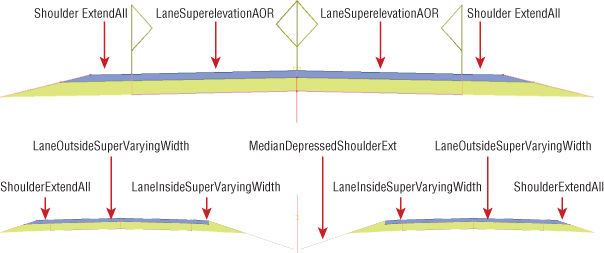
Axis of Rotation Support
The axis of rotation (AOR) subassembly can be used when the centerline of the road is not the pivot point for superelevation. The “flag” symbols (as shown in Figure 12.12) indicate potential pivot points on the assembly.
Figure 12.12 AOR subassemblies used on an undivided, crowned roadway
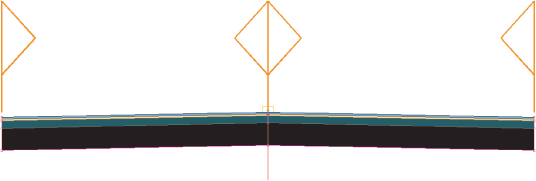
The flag symbols on LaneSuperelevationAOR indicate where the lane can be pinned down and used as a pivot point. When the axis of rotation is not the centerline of the road, the lane geometry is used to determine the change in elevation that will occur as a result.
- Don't use an offset assembly with an axis of rotation superelevation assembly. Doing so can throw off the superelevation calculation.
- When working with curbs, medians, and shoulders, keep an eye out for the parameter Superelevation Axis Of Rotation. If this parameter reads Unsupported, it means that the subassembly will not adjust for superelevations other than at the center. None of the curb and gutter subassemblies will adjust for breakover or rollover, but most of the shoulder assemblies do. This is a “hard-coded” parameter that cannot be changed by the end user.
When building assemblies with LaneSuperelevationAOR you may see warnings appear, as shown in Figure 12.13.
Figure 12.13 A warning symbol on an assembly using LaneSuperelevationAOR

Here are some of the warnings you may encounter:
Center Pivots Not Applied When Only One Group
This usually occurs when you start your assembly with a median at the center. The construction of the assembly then does not have a distinct left and right group. The fix is to build your assembly with left and right sides, and add the median last.
Unsupported Subassemblies
This warning will appear when you're attempting to use an assembly that has the Superelevation Axis Of Rotation parameter absent from its parameters.
Unsupported in Assemblies Containing Offsets
Using an offset assembly will interfere with the software's ability to calculate the correct slope and curve widening on a superelevated road. Therefore, offset assemblies are not recommended for use with the AOR subassembly. You can still use offsets in traditional center-pivot based superelevation.
No Center Pivots Found
Make sure your assembly properties list the assembly as the correct type. For example, if you accidentally set Assembly Type to Divided Crowed Road when it is actually an Undivided Crowned Road, you will receive this message. Check the Construction tab of the assembly Properties dialog to verify.
You can still add assemblies with warnings to a corridor; however, the superelevation may not behave as expected.
![]()




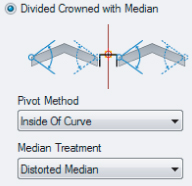


Applying Superelevation to the Design
Civil 3D takes into account other factors such as curve station locations and assembly geometry. Superelevation information is associated with the alignment, but is handed in a separate calculation area. In this section you will put all the pieces in place that are needed for the software to dynamically apply superelevation or cant to your design.
Start with the Alignment
To begin applying superelevation to the design, select your alignment:
Figure 12.14 Roadway type specification for superelevation
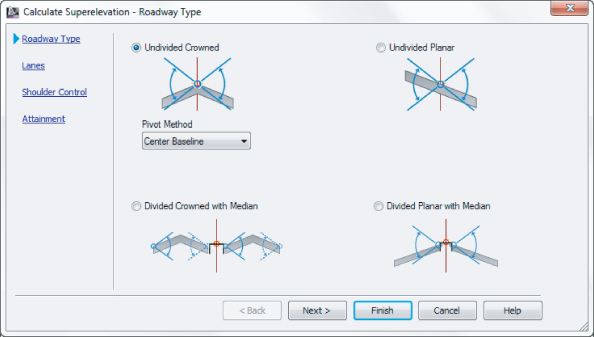
Figure 12.15 Lane information
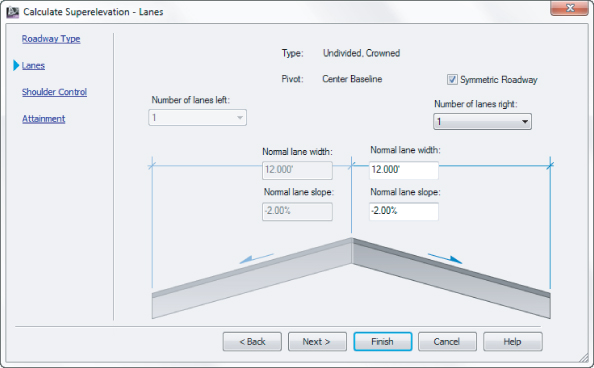
- Set the Low Side option to Breakover Removal.
- Set the High Side option to Default Slopes.
- Place a check mark next to Maximum Shoulder Rollover and set the value to 8.00%.
Figure 12.16 Shoulder Control and Breakover Removal parameters

Figure 12.17 Finalizing the superelevation on the Attainment screen
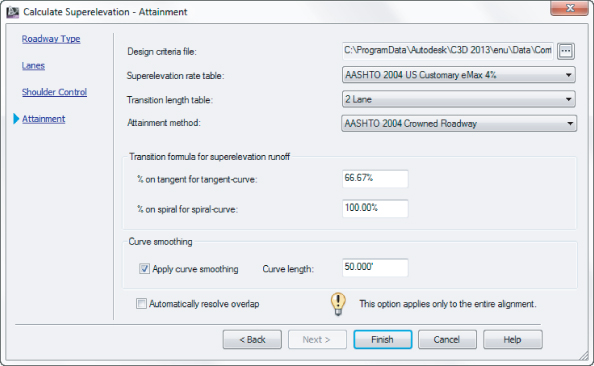
You should now seethe superelevation table appear inside Panorama with the data resulting from the wizard. Examine your alignment; you should now have labels showing the superelevation critical stations created by the wizard.
As you click in the table, you will see helpful glyphs showing you which superelevation station and corresponding curve you are editing, as shown in Figure 12.18.
Figure 12.18 Superelevation table with glyphs in the graphic

Transition Station Overlap
It is not uncommon to have overlap warnings in your superelevation table. You should resolve the transition station overlap before you continue your design.
Overlap occurs when there is not enough room between curves to fully transition out of one curve and back into the next. Transition station overlap will always occur when a reverse curve or compound curve exists in your alignment. As you can see in Figure 12.19, Curve 1 does not complete its transition out until station 16+82.56, but according to the attainment calculations, Curve 2 will begin affecting the shoulder starting at station 15+35.24.
Figure 12.19 Superelevation table showing overlap between two curves
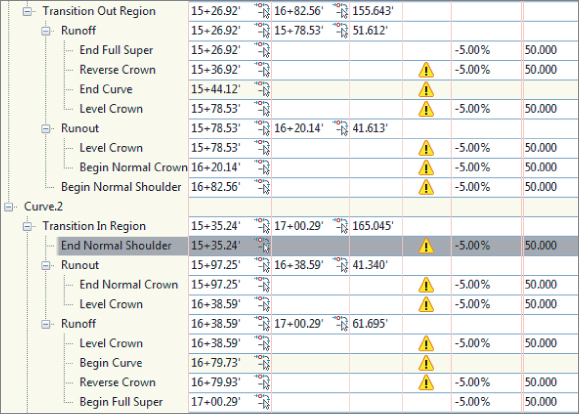
You have several options for fixing superelevation overlap:
- You can choose to have Civil 3D rectify the overlap for you.
- You can manually modify the stations in the table.
- You can change the stationing for superelevation by modifying the superelevation view, which we will discuss later in this chapter.
To have Civil 3D clear the overlap for you, click the warning symbol that appears in the Superelevation Tabular Editor. Civil 3D resolves overlap by omitting noncritical stations and/or by compressing the transition length between certain stations. In the case of a reverse curve, Civil 3D will pivot the road from full-super to full-super, without transitioning back to normal crown. Be sure to verify that the software has made the update that meets the requirements of your locale.
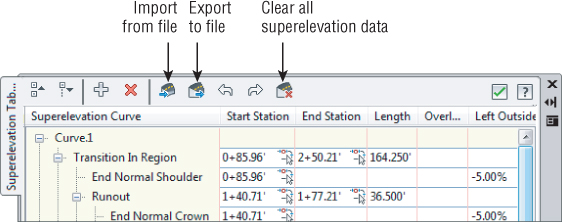
Oh Yes, You Cant
In the civil engineering industry, the terms superelevation and cant are often used interchangeably. Inside Civil 3D, the terms have distinct meanings (Figure 12.20).
Figure 12.20 Example cant data table

Superelevation tools in Civil 3D are used for roads where the cross-slope changes within a curve are expressed by a percentage. Unlike superelevation, cant is expressed as a difference in height between the outer and inner rails.
Workin' on the Railroad
Cant tools are new to Civil 3D 2013 and are specifically designed for rail. In order to work with cant, the following must be in place:
Alignment Type Set to Rail
Normally, you would set the alignment type when you first define the alignment. If you forget to set this initially, you can change it at any time in the alignment properties on the Information tab.
Alignment Design Speed
Like motorways and superelevation, rail requires a design speed in order to apply cant. Cant design standards are provided with the software, and can be edited in the same manner as other design criteria files.
Cant Calculated
Like superelevation, cant is attached to an alignment and its curves. As seen in Figure 12.21, the icon's location in the Alignment contextual tab should be reminiscent of the superelevation button.
Figure 12.21 Accessing the Cant Calculation tools from the Rail Alignment contextual tab
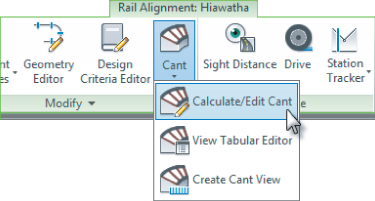
Rail Assembly
When working with an assembly for rail, the type must be set to Railway. You can set this on assembly creation, or in the assembly properties after the fact. There is one subassembly that is purpose-built for cant, the Rail subassembly, as shown in Figure 12.22. If you are working with a drawing created in a previous release, make sure you replace the old assemblies with this new rail subassembly to ensure cant takes place.
Figure 12.22 The new rail subassembly

Creating a Rail Assembly
You will find the Rail assembly in the Bridge And Rail tab of the tool palettes. The following exercise will walk you through creating a typical rail bed design:
Figure 12.23 Placing an assembly to represent additional subballast for a service road next to the rail bed

Figure 12.24 Your completed rail assembly

Applying Cant to the Alignment
Like superelevation in a roadway alignment, cant is related to a rail alignment. The following exercise will walk you through applying cant to the alignment. You should experience a distinct déjà-vu feeling if you completed earlier exercises involving applying superelevation to the alignment.
You should observe that your section views show the cant applied to the design.
Superelevation and Cant Views
Superelevation and cant views are a graphic representation of the roadway or rail superelevation. Grip edits to the graphical view will also edit the superelevation stations. The view itself is not intended for plotting. The superelevation view plots station against lane slope to form a sort of profile of the left and right edges of the pavement.
At first glance, the superelevation view may seem difficult to read, but with a little explanation it can shed a lot of light on what is going on with your lane slopes. Figure 12.25 shows the superelevation diagram for a two-lane road that contains a reverse curve. The superelevation graphic plots the station value against the percent cross-slope of each edge of pavement. The upper line shows the behavior of the right edge of the pavement, and the lower line shows the left edge of the pavement.
Figure 12.25 The superelevation view

Where no superelevation is applied, the graph data is flat. As the assembly twists into position during superelevation, the distances between the lines become greater as the right edge slopes up to a maximum superelevation of 5.6%. You can also see in Figure 12.25 how Civil 3D has resolved overlap between the two curves. Neither line goes back to the default position at -2.00% until the end of the alignment. The crisscross in the center indicates that the roadway transitions directly from one max super to the other.
Place the view into Civil 3D by selecting the alignment and clicking Superelevation ⇒ Create Superelevation View. To simplify the view and make it easier to edit, you can choose which lanes to show or hide at the bottom of the view, as shown in Figure 12.26. You should also change the colors for left and right edge of pavement by clicking the ByBlock option and changing it to the color of your choice.
Figure 12.26 Creating a superelevation view

To modify superelevation data using the graphic, click on it to activate the numerous grips. Figure 12.27 shows a close-up of some of the grips you will see.
Figure 12.27 Grip-editing is another method for fine-tuning your superelevation stationing.

The diamond-shaped grips can be slid in one axis to modify stationing (the horizontally oriented grips) or slope (the vertically oriented grips). The rectangular grip can be moved to reduce the maximum lane slope when it is in a full-super state.
The Bottom Line
Add superelevation to an alignment.
Civil 3D has convenient and flexible tools that will apply safe, correct superelevation to an alignment curve.
Master It
Open theMaster Super.dwg (Master Super_METRIC.dwg)file, which you can download from www.sybex.com/go/masteringcivil3d2013. Set the design speed of the road to 20 miles per hour (35 km per hour) and apply superelevation to the entire length of the alignment. Use AASHTO 2004 Design Criteria with an eMax of 6% 2-Lane.
Create a superelevation assembly.
In order for superelevation to happen, you need to have an assembly that is capable of superelevating.
Master It
Continue working in Master Super.dwg (Master Super_METRIC.dwg). Create an assembly similar to the one in the top image of Figure 12.11. Set each lane to be 14′ (4.5 m) wide, and each shoulder to be 6′ (2 m) wide. Leave all other options at their defaults. If time permits, build a corridor based on the alignment and assembly.
Create a rail corridor with cant.
Cant tools are new to Civil 3D 2013 and allow users to create corridors that meet design criteria specific to rail needs.
Master It
In the drawing MasterCant.dwg (MasterCant_METRIC.dwg), create a Railway assembly with the RailSingle subassembly using the default parameters for width and depth. Add a LinkSlopetoSurface generic link with 50% slope to each side. Add cant to the alignment in the drawing using the default settings for attainment. Create a corridor from these pieces.
Create a superelevation view.
Superelevation views are a great place to get a handle on what is going on in your roadway design. You can visually check the geometry as well as make changes to the design.
Master It
Open the drawing MasterView.dwg (MasterView_METRIC.dwg). Create a superelevation view for the alignment. Show only the Left and Right Outside Lanes as blue and red, respectively.
